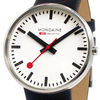 Time. A highly valued asset in much of supply chain management and logistics operations. Time matters. Too little time due to delayed deliveries or late arrivals can cause havoc and supply chain disruptions, too much time due to production slack or early arrivals are equally annoying. Time is important and a supply chain works best when it is on time. For passenger trains it is definitely imperative to be on time and in 1944, Hans Hilfiker (1901-1993), a Swiss engineer and designer and employee of the Federal Swiss Railways, created a clock, which has since become known as the “Official Swiss Railways Clock”. This clock is a Swiss a national icon. It ensures that all trains run on time and that all stations show exactly the same time. This is the story of how the clock came about and what it means to me.
Time. A highly valued asset in much of supply chain management and logistics operations. Time matters. Too little time due to delayed deliveries or late arrivals can cause havoc and supply chain disruptions, too much time due to production slack or early arrivals are equally annoying. Time is important and a supply chain works best when it is on time. For passenger trains it is definitely imperative to be on time and in 1944, Hans Hilfiker (1901-1993), a Swiss engineer and designer and employee of the Federal Swiss Railways, created a clock, which has since become known as the “Official Swiss Railways Clock”. This clock is a Swiss a national icon. It ensures that all trains run on time and that all stations show exactly the same time. This is the story of how the clock came about and what it means to me.
Acknowledgement
First off I have to admit that sometimes the ideas for my own blog posts come from other blogs and the inspiration for this particular post came from risczar’s Watch Risk Management, with a similar yet unrelated topic.
The Swiss Railways Clock
The late Hans Filfiker had to solve the problem that all trains are subject to: How can you make sure that the trains leave at the exact time from all train stations across entire Switzerland? Supposedly, the story goes like this:
Back in the 1940s when the Swiss Federal Railways (SBB) was looking for a way to take advantage of their name for punctuality and incorporate this theme into their national image, they asked Hans Hilfiker, an SBB employee, engineer and prolific inventor, to come up with a highly visible clock that would not only form the basis of their later corporate identity, but it would help to guarantee on time departures as well. Hilfiker, an exponent of products that were both functional and well designed, created the Railways’ masterpiece in 1944. The copyrighted design, with its clear and easily read face, mimics the smooth running of the trains and incorporates clever features that demonstrate punctuality in a highly visible fashion.
What he came up with has been popularized as the “stop-to-go” movement: The second hand completes a minute in just 58.5 seconds, then stops, and at a one-minute interval an electric impulse is sent to all clocks which notches the minute hand forward one minute while at the same time starting the second hand again:
A station clock owes its technology to the particular requirements of operating a railway. On the one hand, railway timetables don’t list any seconds; trains always leave the station on the minute. On the other, all the clocks at a railway station have to run synchronously in order to indicate a reliable time for both passengers and railway personnel anywhere on or around the station premises. That’s why station clocks are slave minute-stepper clocks which receive an electrical impulse from a central master clock at each full minute, allowing the minute hand to electromechanically advance one minute further. The second hand is driven by an electrical motor independent of the master clock. It requires only about 58.5 seconds to circle the face once, then the hand pauses briefly at the 60 second position. It starts a new rotation as soon as it receives the next minute impulse from the master clock. This so-called ‘stop to go’ second hand was designed in 1955 by Hans Hilfiker, a Swiss engineer, together with Mobatime, a clock manufacturer.
If your browser supports Flash, you can see the “stop to go” movement in action below, every time the second hand passes the full minute or “12” hour marker:
[swfobj align=”center” src=”http://www.sbb.ch/media/sbbclock/clock.swf?timeserver=/content/sbb/de/desktop/home.servertime.html”]
This ensures that all trains leave the station at the exact time, to the minute exact, so there can be no complaining of the train leaving too soon or too late.
Simple yet effective
The Swiss Railways Clock truly is a Swiss design classic:
The clock face is simple and strong. There are no figures: the minutes are denoted by black lines on the white face. The hour and minute hands are also black. Against this black and white background the red second hand stands out. It was nicknamed the “rote Kelle” or “red signal” because of the red disc at the end of it, mimicking the hand-held signal which the station manager used to wave to tell the driver the train could leave.
Despite having no numbers, the clock is readable at a glance. Its striking red second hand is a small replica of the station manager’s hand-held departure signal and can be seen from great distances allowing passengers to know exactly how much time is left before the minute is up and the train will depart. This second hand has become a symbol of Swiss punctuality. Historically Swiss trains were, and still are, timed to the second and depart on the full minute. As the second hand on the station clock reached the 12, the station manager waved his distinctively shaped, hand-held signal to the conductor to indicate the train’s departure.
These clocks are now found not only in Switzerland, but in fact, around the world at train stations, airport terminals, offices and homes. They are even sold as watches, under the brand name Mondaine.
A passion or a hobby?
 The Mondaine watches don’t come cheap, and many are collectors’ items and investment objects to say the least. My chosen model, the Sports Gents Night Vision, retails at $355 on amazon.com
The Mondaine watches don’t come cheap, and many are collectors’ items and investment objects to say the least. My chosen model, the Sports Gents Night Vision, retails at $355 on amazon.com and here in Norway it sells at a price much above that. Is it really worth it? And why does anyone need such an expensive watch anyway? A valid question. However, in end what convinced me was that what may look like just an expensive hobby on the outside, is actually a passion investment in fine art or fine goods, as I wrote about in an earlier post on how to hedge risk effectively.
Saying goodbye to a favorite?
 It’s quite a step up from my previous favorite wristwatch, the Casio F91W, another design classic, and retailing at less than $12 on amazon.com
It’s quite a step up from my previous favorite wristwatch, the Casio F91W, another design classic, and retailing at less than $12 on amazon.com. I’ve worn out a couple of these over the years, and I still enjoy wearing it. I don’t know why I like the Casio so much, perhaps because it reminds me of the first watch I bought for the first money I ever earned. Just for the record, the F91W was introduced in 1991, and I started earning money in 1980, so I must have bought an earlier and similar model, but it’s that long ago that I can’t remember the exact model, only how it looked like.
A watch for supply chain managers?
 Speaking to the (only) Norwegian importer of Mondaine watches from whom I bought my watch, he told me that this is not the most wanted watch brand in Norway, and only beginning to gain popularity. However, he said, it is very sought after in academic and engineering circles. Being an engineer myself, I can understand that the simplicity of the clock appeals to designers and engineers, and considering how important time is in logistics, and the history of the clock, perhaps this is also the ultimate watch for supply chain managers? To me it is.
Speaking to the (only) Norwegian importer of Mondaine watches from whom I bought my watch, he told me that this is not the most wanted watch brand in Norway, and only beginning to gain popularity. However, he said, it is very sought after in academic and engineering circles. Being an engineer myself, I can understand that the simplicity of the clock appeals to designers and engineers, and considering how important time is in logistics, and the history of the clock, perhaps this is also the ultimate watch for supply chain managers? To me it is.
On time or not on time – important?
Time is important, even in the Maersk Slow Steaming project and every time I look at my watch I am reminded of how precious time is, first, when considering the price of my watch, obviously, and second, when considering the role that on-time shipments play in logistics and supply chain management. Time is precious, indeed.
What about you, how important is time to you and what watch do you have?
Links
- wikipedia.org: Hans Hilfiker
- mondaine.com: Mondaine Watches official website
- heyday.no: Mondaine Watches (Norwegian retailer)
- risczar.com: Watch Risk Management
Downloads
- swiss-miss.com: Swiss Railway Clock as iPhone App
- sbb.ch: Swiss Railway Clock as screen saver for the desktop
Related posts
- husdal.com: Railway logistics in WWII Germany












